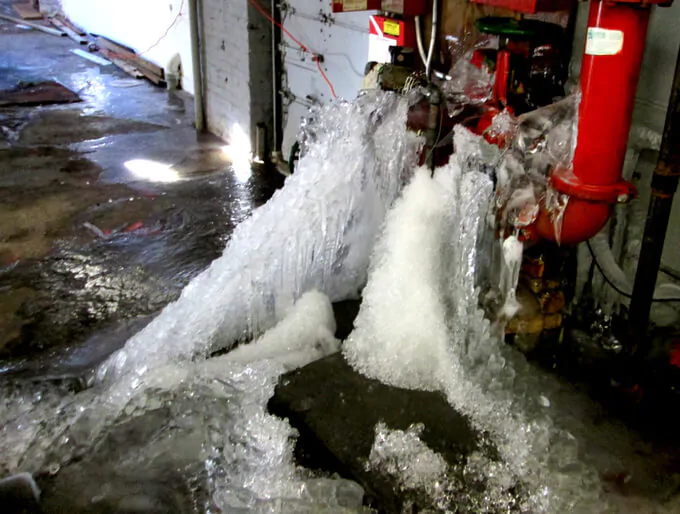 Add My Company
Add My Company
How to Winterise a Fire Sprinkler System

As the colder months approach, building owners and facilities managers across the UK must pay close attention to a crucial aspect of building safety: preparing their fire sprinkler systems for winter.
Proper maintenance and preparation are vital to ensure these life-saving systems remain fully operational during freezing conditions.
At Applications Engineering, we understand the importance of maintaining your fire sprinkler equipment throughout the year. Here, we outline the essential steps for winterising your commercial fire sprinkler system.
Understanding the Risks of Cold Weather
Frozen water in fire sprinkler systems can cause significant damage to components such as fire pumps, sprinkler tanks, valves, pipework, fittings, and sprinkler heads.
More importantly, it can render the entire sprinkler system inoperative, putting the safety of your building and its occupants at risk. It’s essential to make provisions to prevent any part of the sprinkler system from freezing. While it may be easy to identify vulnerable areas, some parts of the system may be harder to assess.
Key Areas to Check
- Exposed Areas: Pay special attention to external loading canopies, unheated loading docks, and storage areas.
- Intermittently Heated Spaces: Buildings that are usually heated but may be left unheated during holiday periods need close inspection.
- Unheated Ceiling Voids: These spaces are particularly susceptible to freezing.
- Areas Near Openings: Sprinklers near delivery doors, hatches, or louvres require extra protection.
Regardless of the season, regular fire protection system maintenance is critical. Ensure your system complies with BS EN 12845: 2015 + A1: 2019 and the LPC Rules for Automatic Sprinkler Installations 2015.
Types of Fire Sprinkler Systems Requiring Extra Winter Maintenance
- Wet Pipe Systems: These systems, always filled with water, require careful monitoring of ambient temperatures.
- Dry Pipe Systems: Although less prone to freezing, ensure air compressors are correctly installed and in good working order.
- Alternate Wet and Dry Pipe Systems: If your building uses this older system type, plan for the autumn changeover from water to air.
- Pre-Action Systems: Ensure both the air charge and the associated detection system are functioning correctly.
- Tail-End Systems (also known as Subsidiary Pipe Systems): Pay special attention to these extensions in unheated areas.
Key Fire Sprinkler Winterisation Steps
-
Trace Heating Systems:
- Ensure all trace heating is operational and conduct weekly checks as per TB 203.2.2.6.
- Confirm duplicate heating elements are installed and working.
- Have a qualified contractor inspect all electrical components, including overload devices and RCDs.
-
Lagging:
- Inspect and replace any damaged or worn pipework insulation.
- Ensure all insulation meets current Euroclass standards.
-
Enclosures:
- Check that valve sets and pump enclosures are equipped with automatic heating.
- Verify thermostat settings and functionality.
- Ensure louvres are suitable and operate as required.
-
Sprinkler Pumphouse:
- Maintain temperatures of at least 4°C in electric pumphouses and 10°C in diesel pumphouses.
-
Tanks:
- Test tank immersion heaters to prevent ball valve freezing.
- Ensure supply and suction pipework are properly protected.
- Drain pump test return pipework to prevent freezing.
-
System Drainage:
- Drain wet pipe, alternate, and tail-end air systems thoroughly before winter.
- Inspect pipework for damage or incorrect drainage slopes.
-
Air Compressors:
- Service and check all air compressors for dry, alternate, and pre-action systems.
-
Underground Pipework:
- Ensure all underground pipes are at least 750mm below ground level.
In Summary
- Review the potential impact of extended freezing periods.
- Ensure staff are trained and available for routine weekly testing.
- Plan for safe water discharge during tests to prevent ice formation.
- Maintain an adequate stock of spare parts.
Applications Engineering: Your Partner in Fire Sprinkler System Protection
Although we don’t handle installations, Applications Engineering offers a wide range of high-quality fire sprinkler components that are essential for effective winterisation, including:
- Dual Port Residential Valve Sets
- Ball Valves & Monitors
- Priority Demand Valves
- Pump Set Products
- Check Valves & Strainers
- Fire Sprinkler Flow, Level, and Pressure Switches
- Pressure Control Valves
- Butterfly & Gate Valves
- Solenoid Valves
- CPVC Fittings & Adaptors
- Metal Fittings
Our products are designed to meet the rigorous standards of UK fire protection and significantly enhance the resilience of your sprinkler system during winter.
Ready to Upgrade Your Fire Sprinkler System for Winter?
Contact Applications Engineering today to discuss how our high-quality components can enhance your fire sprinkler system’s winter readiness. Our team of experts is ready to offer advice on the best products for your specific needs, ensuring your system remains fully operational, no matter how cold the weather gets.
For more information on How to Winterise a Fire Sprinkler System talk to Applications Engineering Limited

